Hello fellow steemians, it's been another wonderful week and a great pleasure to attend this week's lecture. All thanks goes to the Almighty Allah and also a big thanks goes to Professor @awesononso who took his time and make sure to digest this lecture to our understanding. This lecture was really helpful as I learned a lot from it.

My homework submission for this lecture is below.


Satoshi Nakamoto is a pseudonym title for the unidentified person or group that is believed to have established Bitcoin and also publicized its whitepaper. The real identity of the individual or organization behind the creation stays a dilemma.
The actual gender of Satoshi Nakamoto, the nationality, educational level and any proof about this individual or organization are uncertain and questionable.
Because we live in an era where it is almost impossible to have a private life, Satoshi Nakamoto managed to maintain a sense of mystery for about 13 years, which is very fascinating.
At the time of its launch, Bitcoin (BTCUSD) was envisioned by its inventor Satoshi Nakamoto as a medium for daily transactions. The main ideology behind the decentralized cryptocurrency is to eradicate the centralized control and dominance of funds by government agencies and guarantee the quick and fast processing of transactions. About more than a decade later, spectators challenged whether cryptocurrencies failed to deliver on this promise.
Few daily transactions use Bitcoin as a medium of exchange.
Compared with transactions conducted with fiat currencies, Bitcoin transactions have many advantages, such as low transaction fees and faster processing speeds.
Bitcoin transactions are particularly useful for international transfers. With the advancement of technologies such as the Lightning Network, the possibility of using Bitcoin for payment has increased.
Although Satoshi Nakamoto worked together with additional engineers and innovators during the genesis of Bitcoin he did not share his personal information with the general public.


Despite numerous efforts to uncover the identity of Satoshi Nakamoto, he has proven inaccessible. There are several people or individuals who have been recommended but none of them have been confirmed to be Satoshi Nakamoto beyond a doubt.
Here are two candidates who are been proposed to be Satoshi Nakamoto.
Dorian Nakamoto
Dorian Nakamoto was perhaps one of the most high-profile attempt to reveal the founder of Bitcoin.
Dorian Nakamoto was identified as the founder and creator of Bitcoin in March 2014 by Newsweek. The publication of this article in cryptocurrencies and the technical community in general caused a stir, because this is the first time that a mainstream publication has tried to understand the identity of the creator of Bitcoin.
Newsweek claims that there are several similarities between Satoshi Nakamoto and Satoshi Dorian. For example, it is said that they all have liberal tendencies and connections with the Japanese (Dorian graduated from California Institute of Technology with a physics major and is engaged in classified defense projects. He is a Japanese-American).
The author of this article also claimed that Satoshi Nakamoto said he "no longer participates in Bitcoin, but will give it to other people".
Dorian Nakamoto later denied this sentence, claiming that he misunderstood the issue. Dorian Nakamoto made it clear to the Associated Press that : "I have nothing to do with this matter."
The biggest mistake of the magazine was to publish a picture of Satoshi Nakamoto's house. A cursory image search can easily show your location.
Although many people do not believe that Dorian Nakamoto is the founder of Bitcoin, the crypto community is shocked by the violation of their privacy. However, the media circus is still beneficial to Dorian Nakamoto. A campaign which was held online raised more than 100 bitcoins on his behalf. The amount raised was the bitcoin community way of saying “thanks” to Satoshi Nakamoto.
In the year 2014, Dorian appeared during a video on YouTube alongside a fundraiser called Andreas Antonopoulos to mention and give thanks to the bitcoin community for their immense support towards the growth of the blockchain.
Nick Szabo
Nick Szabo, a computer engineer and a lawyer pioneered the concept of smart contracts in an article in 1996. In 2008, Nick Szabo conceptualized a decentralized currency called Bit Gold, the predecessor of Bitcoin.
He described Bit Gold as a protocol through which expensive, non-counterfeit bitcoins can be created online with the least reliance on trusted third parties. This is similar to the concept of Bitcoin, in which a series of bit verification and validation transactions created by a computer network without a leader.
"Bitcoin: The Future of Money?", a book written by Dominic Frisby indicated that, Nick Szabo is considered Satoshi Nakamoto. Frisby consulted a stylistics expert, and he concluded that Nick Szabo writing style is similar to that known to Satoshi Nakamoto.
Another clue is that both Szabo and Satoshi are referring to economist Carl Menger. Additionally, Frisby learned that Szabo had worked at DigiCash, which was one of the first attempts to introduce encryption(crypto) technology into digital payments. In the author's opinion, this strongly suggests that Nick Szabo is Satoshi Nakamoto.


Wei Dai is a cryptographer and member of the cypherpunk community who is well known for his contributions to the field of research. In the cryptocurrency world, people will remember that he made a key pioneering proposal for Bitcoin and "crypto" libraries before Satoshi Nakamoto was founded.
As a cypherpunk, Wei Dai's private life is a mystery and nothing is known about it. However, he is known for having a computer science degree from the University of Washington. He also specializes in mathematics. Two areas allowed him to demonstrate his talents in creating world-class encryption(crypto) systems and solutions.
Wei Dai began his career as a programmer at TerraSciences, a company in Acton, Massachusetts. At this company, Mr. Dai was committed to developing security solutions for the oil and gas industry and secure communications for control stations.
Later, Wei joined Microsoft Corporation, a crypto research group based in Redmond, Washington. During his work at Microsoft, he was involved in the research, design, and implementation of a dedicated application encryption system. It was at that time that patents 5724279 and 6081598 were registered. Both patents are aimed at optimizing the encryption algorithms in the Microsoft technology stack.
This is Wei Dai's proposal for the design of a "distributed and anonymous electronic cash system". Dai posted it on the cypherpunk mailing list in November 1998. In this proposal, Dai explained two ways to implement his system.
First, use Proof of Work (PoW) as a means of generating funds. To this end, b-money can use Hashcash to "mining" b-money. However, due to the need for synchronization channels, the design of the first protocol is not practical. This situation makes it difficult to operate in a real environment distributed all over the world.
The second proposal explains a subset of servers that use maintenance accounts. These servers must publish, manage and verify transaction data. As far as they are concerned, the participants in the transaction verify their balance through the network.
b-money is generally considered the first real cryptocurrency, although it has never been implemented. However, its theoretical basis is almost the same as the theoretical basis followed by current cryptocurrencies.
Crypto++ is a library written by Wei Dai in the open source C++ programming language. The library has been widely used in academia, student projects, open source projects and commercial projects. Among the projects that highlight the use of cryptography, one can mention are as follows:
Symantec Backup (Data Backup System)
Steam (online gaming platform)
Microsoft Office Groove (Office)
Tripwire (Computer Security Tool)
Lastpass (Password Manager)
Due to its potential, cryptography stands out as a multi-purpose library with multiple algorithms and support for various cryptographic systems.
Its documentation, code cleanup, and portability make it one of the most commonly used libraries in programming.
VMAC is an encryption-based(crypto based) Message Authentication Code (MAC) algorithm. The VMAC uses the universal hash suggested by Wei Dai and Ted Krovetz in the year April 2007. The algorithm aims to achieve high performance backed by formal analysis. Wei Dai published the algorithm specification in a very comprehensive post.
Influence on the development of Bitcoin
With the creation of b-money, Wei Dai summarized the core and important theories and concepts that were later implemented in Bitcoin. Among these concepts, we can highlight are;
It needs to use a proof-of-work system to generate coins and protect the network.
The work carried out is verified by the community, which updates the collective accounting books.
The worker received funds for his efforts.
The exchange of funds is done through collective accounting and verified through cryptographic hashes.
Contracts are enforced using digital signatures to transmit and sign transactions. In other words, the operation of the system is based on asymmetric encryption.
Because of this, Wei Dai was originally noted to be Satoshi Nakamoto. Regardless, there is no decisive proof that this is certainly the case. On the other hand, Dai categorically denied that he was the person behind Satoshi Nakamoto's name.


Bitcoin as a cryptocurrency as well as an exchange medium has both small and large units to provide various forms of transactions.
Satoshi is the smallest unit of BTC which is spelled all the time with the smallest letter "s".
BTC has various units and below is a table showing the units of BTC with their corresponding values.
According to coinmarketcap, the current value of 1 BTC is $38,204.18
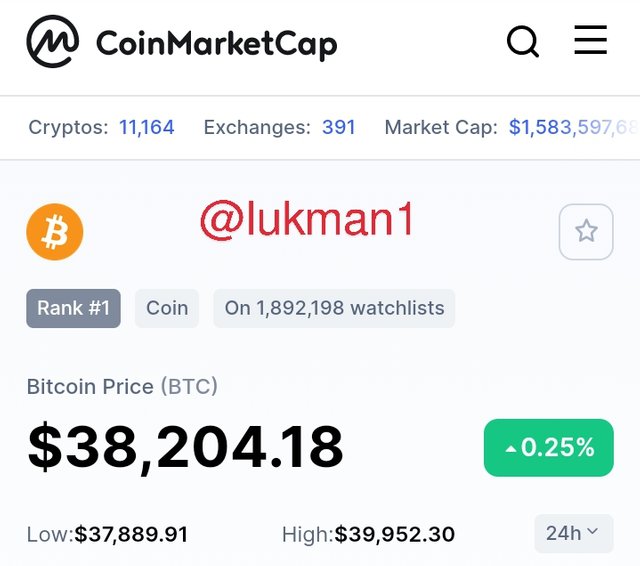
Using this current price to compute for the value of 1 satoshi is shown below:
Since 1 satoshi = 0.00000001BTC
1 satoshi in this case = 0.00000001 * 38,204.18
1 satoshi = 0.0003820418
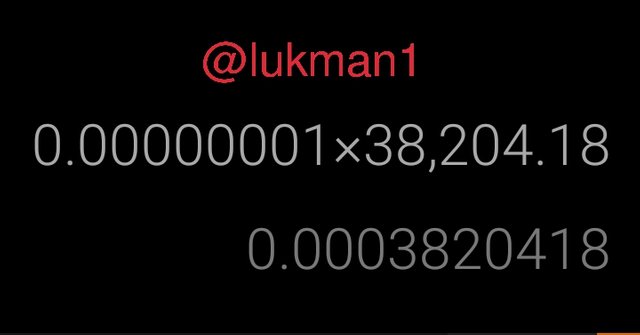
Hence: the value of 1 satoshi per the current market price of BTC is $0.000382 (3 s.f)


Ether also has its units to carryout both small and large transactions just like Bitcoin. The unit of Ether on the Ethereum blockchain is wei. Wei is taken from Wei Dai's name.
The breakdown of the units of Ether as well as it's symbols and values on the Ethereum blockchain is shown in the table below.
According to coinmarketcap, the current value of 1 Ethereum is $2,628.41.
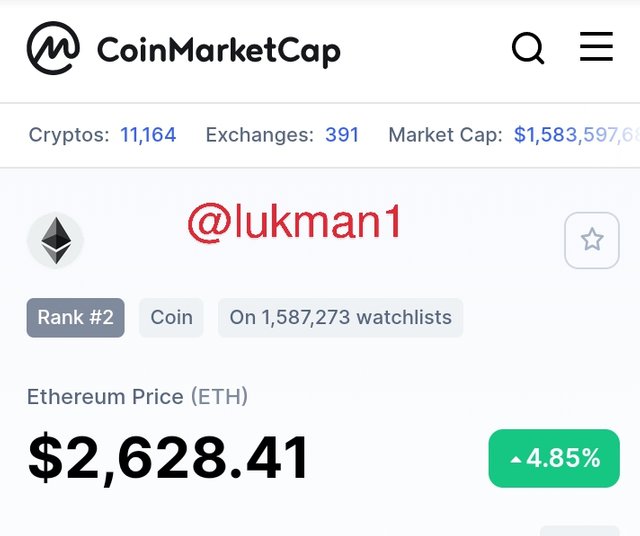
Using this current market price of Ether($2,628.41) to calculate for the value of 1 Gwei is shown below:
Since 1 Gwei = 0.000000001 ETH
In this case, 1 Gwei = 0.00000001 * 2,628.41
1 Gwei = 0.0000262841
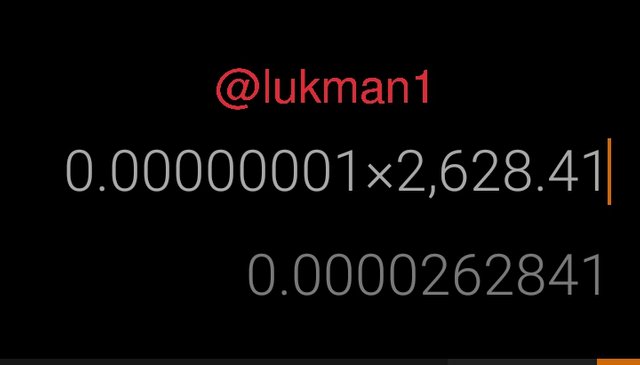
Hence: the value of 1 Gwei per the current market value of Ether is $0.0000263 (3 s.f)


Steem as a cryptocurrency is different from Bitcoin and Ethereum when it comes to calculations using their units. As BTC and Ethereum has their units, steem do not have an official unit purposely meant for the smallest transaction on the blockchain.
I will try to demonstrate the amount of smallest unit of steem that can be transfer from one user to another. Below are the steps to follow:
- Currently I do not have any steem in my wallet so I will buy 0.5 steem to demonstrate this process. I bought the steem from the market into my wallet.
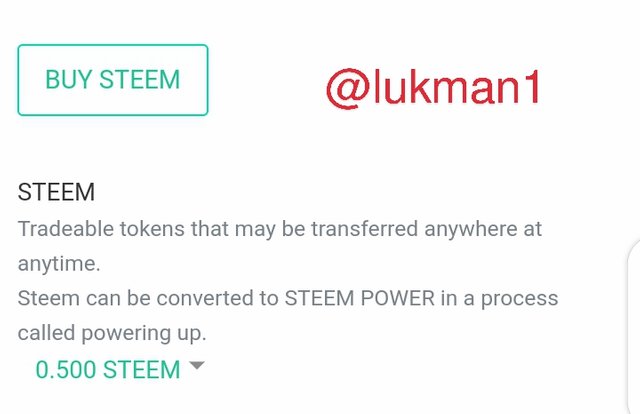
- I then try to send 0.0001 Steem to a brother on steemit called @rubilu123. In doing so, the transaction was not successful because the least amount of Steem permitted by the blockchain to be transferred from one user to another is 0.001steem. This means that the blockchain only accept amount in which the numbers after the decimal point is 3 or less.

- Next, I then try to send 0.001 Steem to @rubilu123. First of all I provide the requirements for the transaction to be successful. I type the username I want to send the steem to and the amount of steem to be sent. The Memo for the transaction is not compulsory but optional, you can decide to fill it or leave it. The transaction will still be successful without any problems.

The next thing is to click on the Next button as shown above.
It took me to the page where they want me to confirm the transfer. I click on the confirmation button which is the okay button as shown below.
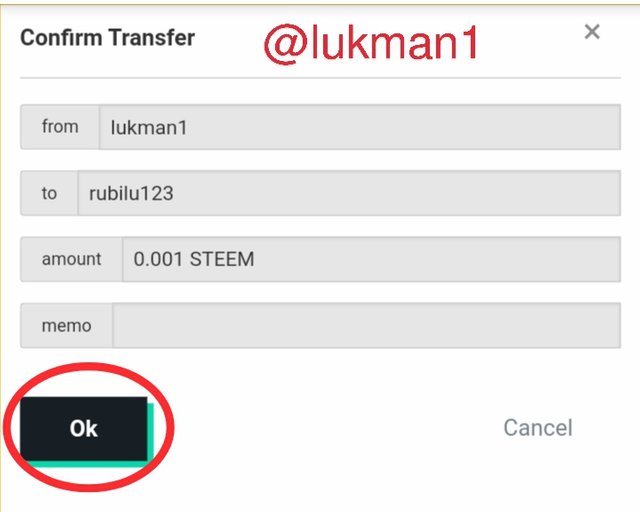
The steem will be sent after the loading is done.
The wallet history of rubilu123 shows that he has received the amount I sent and my wallet also indicates that I have sent 0.001 steem to rubilu123.




Learning about how Bitcoin came into being is so wonderful especially the mystery behind Satoshi Nakamoto.
In conclusion, I will like to give my utmost thanks to Professor @awesononso for this wonderful lecture. This lecture was so practical which made me to enjoy it.
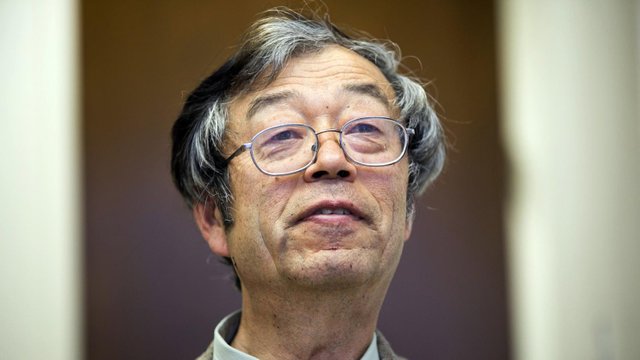

Hello @lukman1,
Thank you for taking interest in this class. Your grades are as follows:
Feedback and Suggestions
You have done a good amount of research on the topic.
There are still some points missing in the post especially in the last question.
Thanks again as we anticipate your participation in the next class.
Downvoting a post can decrease pending rewards and make it less visible. Common reasons:
Submit
Thank you Prof. I will take ur suggestion into consideration and try as much as possible to provide more valuable information in your next class
Downvoting a post can decrease pending rewards and make it less visible. Common reasons:
Submit